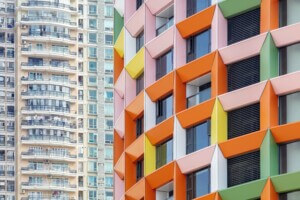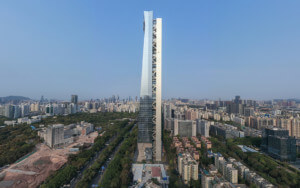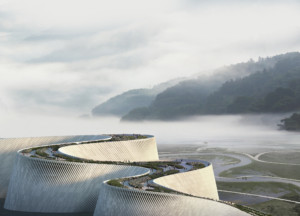Vienna-based firm Coop Himmelb(l)au has completed the Museum of Contemporary Art & Planning Exhibition (MOCAPE) as part of the master plan for the Futian Cultural District in Shenzhen, a major city in Guangdong Province, China. The complex merges two independent institutions—The Museum of Contemporary Art (MOCA) and the Planning Exhibition (PE)—within a structurally unified form. (The latter is an exhibition venue.)
The combined art and exhibition facility consists of a seven-story building which reaches a maximum height of 131 feet, rests on a 233,447 square-foot site, and offers a total of 861,112 square feet of floor space. The building’s irregularly shaped volumes are clad in natural stone louvers and insulated glass, which create a transparent exterior.
Within the complex, the central atrium houses an amorphous reflective structure referred to as ‘the Cloud,’ which houses a café, bookstore, and museum store, while joining the exhibition rooms of both museums with bridges and ramps, according to Perspective. Architects at Coop Himmelb(l)au extended this synergy between the two organizations throughout the complex, with both organizations sharing the lobby, auditorium, conference rooms, and service areas.
According to a press release, “the transparent facade and a sophisticated internal lighting concept allow a deep view into the joint entrance and transitional areas between the buildings. From the inside, visitors are granted an unhindered view onto the city suggesting they are somewhere in a gently shaded outdoor area, an impression enhanced by 6 to 17 meter high, completely open and column-free exhibition areas.”
Energy-wise, MOCAPE utilizes solar and geothermal energy, with a groundwater cooling system in attempts to reduce the facility’s carbon footprint. The transparent roofing of the museum also filters in natural sunlight into the exhibition rooms, reducing the need for artificial lighting sources.










